No. 10
The 1984-85 Loyola Ramblers: A Sweet 16 After a 17-Year Wait
27-6, 13-1 Midwestern City (1st Place)
For 50 years—from 1968 to 2018—the 1984-85 Ramblers were the only Loyola team to make it to the NCAA Men’s Basketball Tournament, and they did it with a flourish. A regular season conference title, a conference tournament title, a non-con win over #4 Illinois at Rosemont Horizon (followed by a convincing win over #20 Louisville at Freedom Hall), a 19-game winning streak, a #14 AP ranking, and a Sweet 16 appearance against the #1 team in the country and defending National Champion.
The individual talent on that team was stellar. Alfredrick Hughes averaged 26.3 ppg and finished his career that season with 2914 career points, at the time the 5th highest scoring player ever in Division I. Even today– 37 years later– Hughes still ranks 13th all time. Hughes was selected 14th overall in the first round of the 1985 NBA Draft. Guard Andre Battle averaged 20.3 points and was a third round NBA Pick by the Celtics. Sophomore center/forward Andre Moore went on to set the Loyola record for career blocks, and earned a 2nd round pick by Denver in the 1987 NBA Draft.
Loyola beat 13 seed Iona in the first round of the tournament 59-58 in a squeaker; Hughes led Loyola with 24 points and the Gaels’ senior forward Tony Hargraves had 19 points (but missed six of his seven free throw attempts). Next up, Loyola defeated SMU 70-57, forcing 7’ center Jon Koncak (the 5th pick in the NBA Draft that year) and the rest of the Mustangs into 19 turnovers.
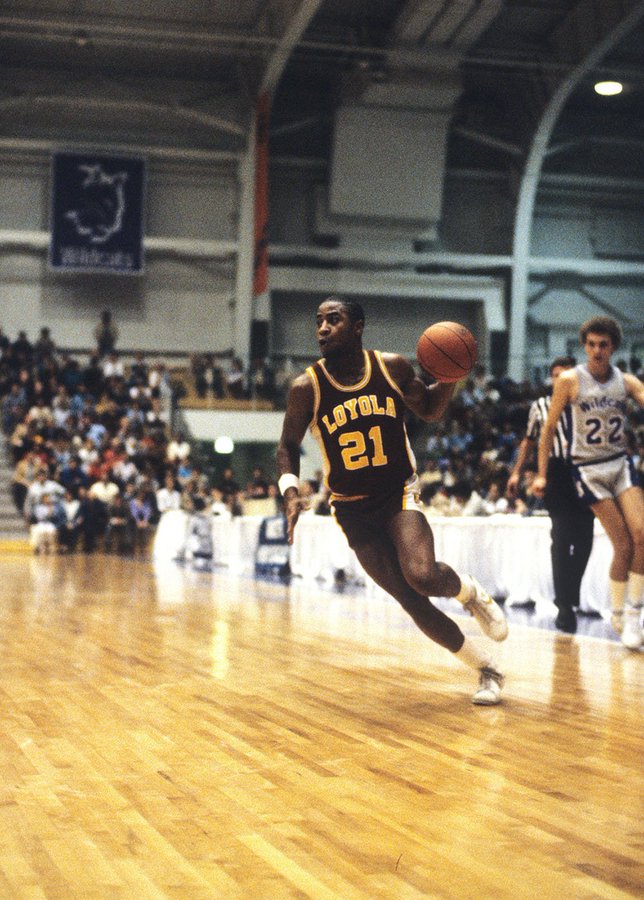
In the Sweet 16 against Patrick Ewing and Georgetown, the Ramblers were great in the first half, taking a 28-26 lead into the locker room at halftime. In the second half the Hoyas shut down the Ramblers’ top three players, holding Carl Golston, Battle, and Hughes to a combined 24 points on 38 field goal attempts for the game.
It was a great showing by the Ramblers. With Golston and Moore coming back, Wichita State transfer Bernard Jackson set to join the team in 1985-86, and some good recruits (Gerald Heyward, Keith Carter) coming in the future looked bright. But it would be 30 years until the next postseason tournament for Loyola, and 33 years until their next trip to the NCAA.
Out of the four times Loyola won the Midwestern City/Midwest Collegiate/Horizon League regular season title, this was the only time the Ramblers won the conference tournament for the automatic bid. Loyola would reach the conference tournament final only one more time during their 28 subsequent years in the conference that became the Horizon League, in 2001-02.
For my generation of Loyola fans, this was the team we looked to as a model of what was possible. And if we had kept doing *this* every five to seven years or so, people might have been fine with it. But recruiting changed, scouting changed, conferences changed, players changed, the economics of college sports changed, but Loyola athletics and administration didn’t change much, at least not until the 21st Century was well underway. When it stops happening every five to seven years and gets into multiple decades without success or satisfaction, it will tend to cull a fanbase.
No. 9
The 1961-62 Loyola Ramblers: NIT 3rd Place, Much Bigger Things in Store
23-4 Overall
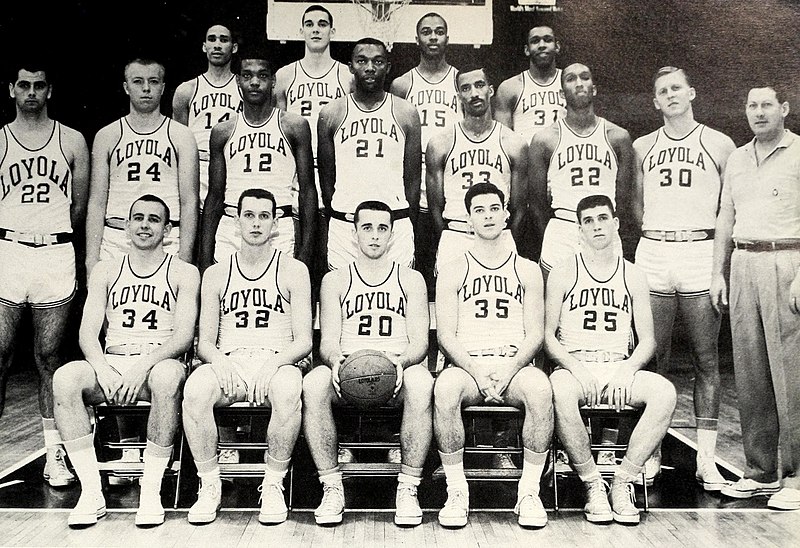
It was no secret that Loyola’s 1962 team was going to be fantastic. The 1960-61 freshman team (featuring Les Hunter, Vic Rouse, John Egan and Ron Miller) absolutely tore apart their opponents without mercy. That freshman team was 12-1 (the loss by three points to a top AAU squad), averaged 96 points a game, and beat opponents like Roosevelt, Valparaiso’s frosh squad, Lake Forest, and local juco squads by as much as 50-80 points.
The only question was, how will Coach Ireland integrate five star-level African American players from the freshman team (Hunter, Rouse, Miller, Floyd Bosley, Rich Rochelle) onto a returning squad with one star African American player (Jerry Harkness) and a senior African-American bench contributor (Alan Ray). Ireland chose to start two white players– senior shooting guard Mike Gavin and sophomore point guard Egan– with Miller as the first man off the bench. In order to mostly hew to the “gentleman’s agreement” of only playing a maximum of three Black players at a time, 6’8” sophomore center Floyd Bosley, 6’10” sophomore center Rich Rochelle, and 6’1” senior guard Alan Ray all had their playing time seriously constrained. That talented trio only saw time in 10 or 11 of the 27 games played that season.
The 1961-62 team was much deeper than the 1963 National Championship team, but not as experienced. The scheduling for that season didn’t present the Ramblers with a lot of opportunities, either. The team’s first loss was a drubbing by #1 Ohio State, the two-time defending champions. The Ramblers lost their 2nd game on the road on Jan. 9 at Marquette, dropping them to 9-2 on the season, but their best win at that point was against unranked Indiana (middle of the pack in the Big Ten) at Chicago Stadium. After a win over Memphis State and a harrowing trip to Loyola New Orleans in which the team experienced a lot of racial hostility, the team really got into a groove. The Ramblers won 12 in a row (including wins over St. John’s, Marquette, and #7 Bowling Green State) before a loss in the regular-season finale at Xavier.
Harkness led the ’62 team with 21.0 ppg and Rouse (13.8), Egan (13.7), Hunter (12.8), Gavin (11.9), and Miller (10.2) also averaging in double digits. Rouse was the top rebounder with 11.3 per game, and Hunter and Harkness averaged 8.7 boards apiece.
The NCAA tournament eclipsed the NIT in prestige sometime in the early 1950s. Although the ’62 Ramblers got invites to both the NCAA and NIT, Ireland chose to take the NIT bid—he said—to give Harness and Miller a chance to play in front of their parents and friends. Sporting an #10 ranking in the AP Poll, Loyola got a bye into the Quarterfinals where they beat Temple, and set to face off against Dayton. The Flyers got to the Quarterfinals by beating Wichita State and Houston to notch their ninth win in a row, at 21-6 overall. Dayton defeated the Ramblers 98-82, and went on to beat St. John’s (a team Loyola beat earlier that season) to win the NIT Championship. Loyola defeated Duquesne in the third-place game, 95-84, the beginning of a 22-game winning streak.
No. 8
The 2017-18 Ramblers: Buzzer-Beaters and Sister Jean on the Big Stage
32-6, 15-3 Missouri Valley (1st place)
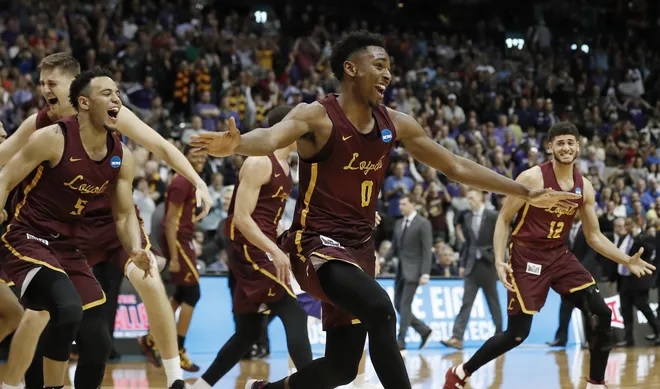
I know it’s going to hit a lot of people wrong that such a beloved, important and memorable team– with an all-time program high of 32 wins!– ranks eighth on this list. But remember, this amazing team probably wouldn’t have made the tournament had they lost in the Arch Madness final.
Loyola’s KenPom rating sat at 45 going into the 2018 MVC Tournament Final, which is high for a bubble team, but would have dropped with a loss to Illinois State. Battling some injuries in December, the team lost by 34 points at Boise State and lost by 17 points at Milwaukee, two bad losses that would have caused the committee to balk. The 2017-18 team also started conference play 1-2 with a low-energy home loss to Indiana State, before winning 21 of their next 22 games en route to the Final Four.
Two newcomers to the roster made an immediate difference and helped make up for the loss of Loyola’s greatest player of the 2010s, Milton Doyle, to graduation. Six-foot-nine center Cameron Krutwig (the 2018 MVC Freshman of the Year) and Fairleigh Dickenson transfer Marques Townes (11.1 ppg on 51.4% field goal shooting) were both in the starting lineup a few games into the regular season. Second-year players Clayton Custer (MVC Player of the Year) and Aundre Jackson helped propel Loyola to the third highest team field goal percentage in all of Division I. MVC Defensive Player of the Year Ben Richardson was a mentor for freshman Lucas Williamson, who emerged as a reliable contributor on both ends of the ball. And Donte Ingram (11.0 ppg and a team-leading 6.4 rebounds per game) stepped up big when needed, earning the Arch Madness MVP award and hitting the game-winning shot in Loyola’s first NCAA Tournament game in 33 years.
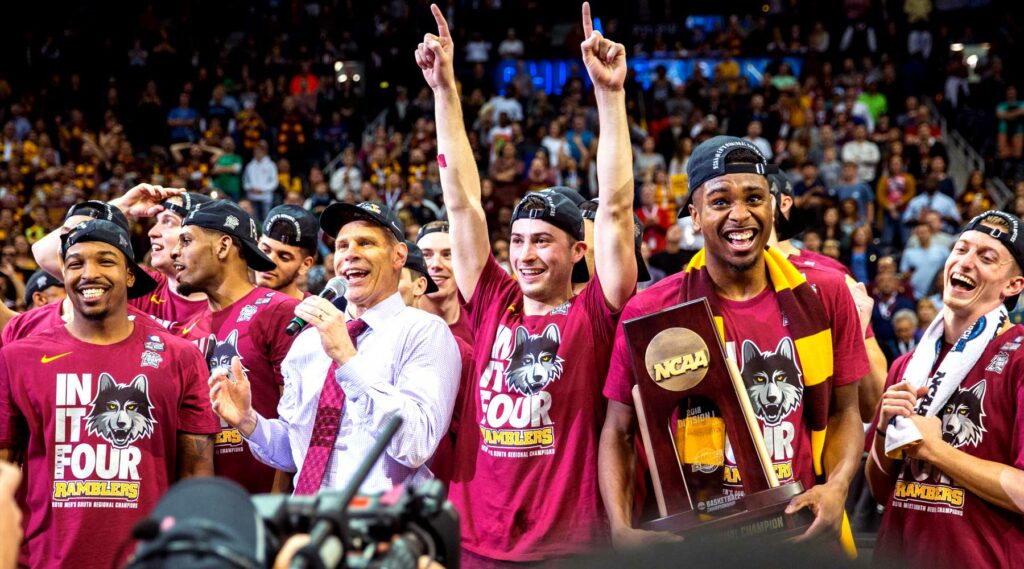
But it didn’t stop there. Custer hit the game-winning shot to beat Tennessee with seconds left. Townes hit the game-clinching shot against Nevada. And Richardson stepped up with a career high 23 points against Kansas State to put the Ramblers in the Final Four for the first time in 55 years. Crazy. Still unbelievable. And with 14 minutes left to play in the game that would send the Ramblers to the National Championship game, Loyola had a 10-point lead. Insane. Ludicrous. Magnificent.
The 2017-18 team was a something akin to a moon launch event for Loyola athletics. Happily, the teams that followed over the next several years helped to reinforce that Loyola has a strong commitment to winning athletics.
No. 7
The 1965-66 Loyola Ramblers: The Best Ramblers Team You Probably Haven’t Heard About
22-3 Overall
The 1965-66 Ramblers were the full fruiting of the next generation of players after the 1963 National Championship, built in a lot of ways similarly to the ’63 team. The ’66 Ramblers were by Billy Smith, who actually started the 1962-63 season with the Ramblers before flunking out, missing a year to rebuild his grades at a New York area juco, and returning to play for Coach Ireland. Joining Smith were seniors Jim Coleman, and Frank Perez. Two sophomores joined the three seniors in the lineup– another New York area recruit– phenom Corky Bell–and Doug Wardlaw, a 5’11 guard.
Like the ’63 team, the ’66 Ramblers wanted to outscore their opponents and use their quickness and athleticism to play defense. This team was deeper than the ’63 squad, with several significant contributors off the bench: sophomores Alan Miller, Jim Tillman, Bob Calihan, and Mike Hogan. Senior Ed Manzke also saw some playing time. The only thing that wasn’t like the ’63 team was the size. Billy Smith and Jim Tillman were 6’5”; Corky Bell and Frank Perez were 6’4”, and those were the only players over 6’2”.
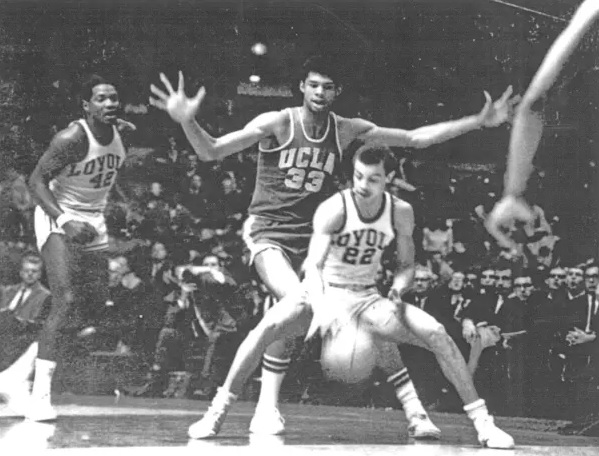
The ’63 team led the nation in with 91.8 points per game. To illustrate how much the game changed after that Loyola championship three years before, the 1965-66 team scored 97.5 points per game and finished fourth in the nation in scoring, after Syracuse, Houston, and Oklahoma City. Loyola led the nation in margin of victory, defeating their opponents by an average of 20.92 points.
After beating two non-University Division (D-1) teams by a combined 111 points to start the season, the Ramblers dropped a home game to Oklahoma City, a team that would make the tournament and was coming off a Sweet 16 in the 1965 NCAA Tournament. The 106-89 home loss to an Independent Oklahoma City team must have lit a fire under the Ramblers. After the loss to OKC, the Ramblers began a 14-game winning streak, winning road games at Missouri, Saint Louis, Indiana, and Marquette; in between, they beat Tulsa, #9 Minnesota, and Marshall at home. In the last three games of that impressive streak, the Ramblers defeated three teams in succession coached by Hall of Fame coaches John Wooden (#10 UCLA), Tex Winter (Kansas State), and Al McGuire (Marquette). As a result, the Ramblers shot up to #3 in the AP Poll.
At 16-1 and ranked #3, the Ramblers stumbled again, losing at Wichita State 92-84. Loyola won out in the last six games of the regular season—including avenging the Wichita State loss with a 94-76 win at Chicago Stadium and beating Sweet 16 team Dayton on the road—to finish the regular season at 22-2. Loyola drew the #10 ranked Western Kentucky Hilltoppers in the first round; WKU was a top 10 defensive team that ended up turning the tables on the Ramblers with a 105-86 upset in the first round.
Texas Western won the National Championship in 1966 by facing off against Kentucky in the 1966 NCAA Tournament Final, a matchup of an all white team versus five African-American starters depicted in the film “Glory Road.” It’s worth noting for Loyola fans and all college basketball fans that Texas Western’s championship happened the same year that Loyola’s next generation of players (after their historic 1963 championship) came of age.
No. 6
The 1963-64 Loyola Ramblers: Preseason #1, Sweet 16, Regional Third Place, and Still… Disappointed?
22-6 Overall
There are only 23 college basketball programs that have ever had one of their teams ranked #1 in the AP Preseason men’s basketball poll in its 74-year history. In the preseason, the usual suspects—top P5 teams– are typically on top.
But in 1963-64, the AP Preseason poll (and the next three weeks of early polls) had Loyola as the #1 team in the nation. Loyola is the only school in Illinois to achieve a #1 pre-season AP men’s basketball ranking—not Illinois, not DePaul, not Bradley. Not even Marquette, Purdue, or Notre Dame.
The particular team in question was the reigning National Champions, the 1963-64 Loyola Ramblers, who were returning four of their five starting players, and had added some quality newcomers and returnees. The newcomers were starter Jim Coleman, a 5’11” sophomore guard; Ed Manzke, another 5’11” sophomore guard; Frank Perez, a sophomore forward at 6’4”; and Tom Markey, a 6’5” sophomore forward. Chuck Wood, a 6’3” senior forward who was a starter on the ’61 freshman team, finally got some limited playing time late in most games.
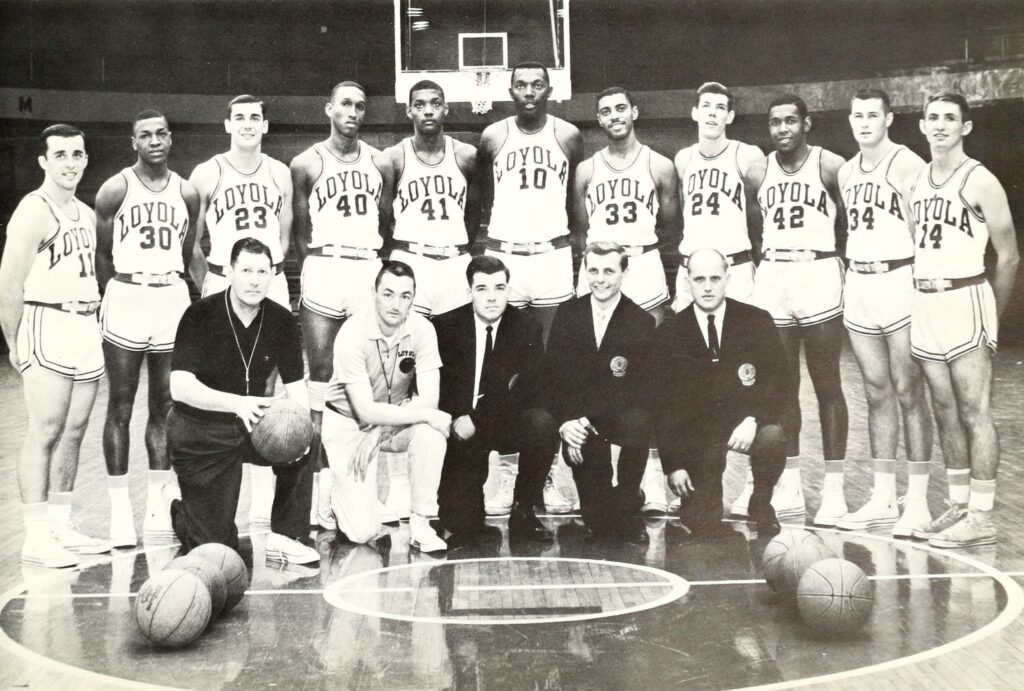
On the ’64 Ramblers, Ron Miller was the one to step up to try and replace the leadership and clutch scoring of Jerry Harkness. John Egan stepped up his scoring as well, switching to more of a shooting guard offensive stance, and newcomer Coleman did more ball distribution than scoring. Miller went from scoring 13.3 points per game on the ’63 team to leading all scorers in ’64 with 21.9 per game.
The ’64 Ramblers started out 6-0, with wins over Kent State, Detroit, and Western Michigan. But unlike past years, the margin of victory on those games against good/average Midwestern teams wasn’t as impressive. Loyola needed overtime to beat Detroit at Chicago Stadium, and the #1 team in the country beat Western Michigan on the road by three points (105-102). After a loss to Georgetown in a defensive battle (58-69) at the Quaker City Tourney in Philadelphia, the Ramblers struggled to defeat Northwestern (88-82) and Temple (74-65).
On New Year’s Eve, Loyola beat Indiana at Chicago Stadium, 105-92, to seemingly get back on track. But that was just it—Loyola was a top three team at home (or at least in Chicago venues), but only a pretty good team on the road. Loyola was 14-1 in home games (the only loss to Wichita State 80-76 at Chicago Stadium), but only 6-4 away from Chicago in the regular season.
At 20-5 and ranked #9 by the AP, Loyola knocked off Ohio Valley champions Murray State 101-91 in the first round of the NCAA Tournament at Welch-Ryan Arena in Evanston. Super sophomore Jim Coleman led the Ramblers in scoring with 27 points in that game. But in the next game against Michigan, the Rambler newcomer got called for a controversial travel.
During Loyola’s 2018 Final Four run, when Loyola was poised to play against Michigan again, a story was pitched on the Ramblermania message board about the controversy, and USA Today responded with an article.
The rough, somewhat controversial 84-80 loss to Michigan was balanced out by a regional third-place win over Adolph Rupp and his Kentucky squad, 100-91. In 1958, Loyola beat Kentucky at Chicago Stadium a few weeks before they won the National Championship. So the 2-game winning streak over Kentucky still stands.
There might not be another college basketball fan base that has experienced such extreme highs and lows as Loyola. Few teams have done anything close to what this 1964 Loyola team did, and yet it feels like a disappointment. No top program in the country has seen anything like the worst years of the program from the late 1980s to the early 2000s. But Loyola fans seem to sense in their bones that the DNA of the program is more like the top programs mentioned in National discussions than the ones left out.
The next five teams show the program’s rich history, coming in five different decades and spanning 92 years.


